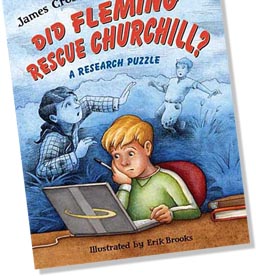
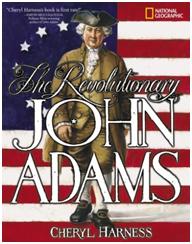


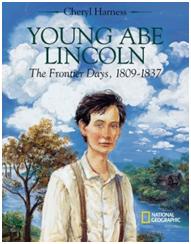
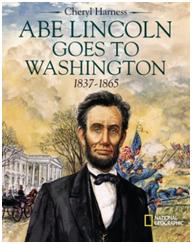
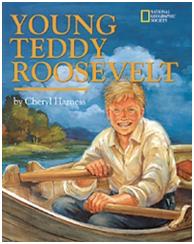
These seven biographies have one thing in common. Nope, they’re not all Presidents (see Benjamin Franklin). They were all written and illustrated by the incomparable Cheryl Harness. There is a different unity of purpose achieved when the illustrator is also the author of the text in a book. Harness is a master of both crafts. She tells a very good story – clear and straightforward, with an instinct that helps her to select the anecdotes and incidents that are intrinsically interesting and character-revealing about her main subject.
In George Washington, Harness shows Washington as a frontier surveyor, Virginia planter, commander of the militia, and quiet delegate to the colonial legislature. She shows the moment at which the Continental Congress selected him to command the Continental army, with the famous founding fathers looking on as a he addresses them, reading from his notes. She shows him crossing the Delaware, seated, cold and grim-faced as he is rowed across to New Jersey, gambling his small army in a surprise attack. Then she shows him in September of 1783, at the end of seven years of war, saying goodbye to his officers at Queen’s Head Tavern in New York after the last British warship had sailed away with the last of the British troops. Four years later, he reluctantly leaves Mt. Vernon and heads for Philadelphia to preside over the Constitutional Convention. It took another ten years, until the spring of 1797 before he could return to live at Mt. Vernon year-round. The last picture Harness gives us is of Washington, aged 68, in December of 1799 out riding through the fields of Mt. Vernon, making his rounds. The chill resulted in a cold which worsened and led to his death on December 14, 1799. This is an excellent biography. Text is written at a 5th-7th grade level and those are the ages who will enjoy the detailed pictures and notes the most, though older readers could learn much from the text as well.
You can tell that Harness feels a certain affection for John Adams by reading her introduction:
“In the nation’s capital, the sun glitters on stone monuments to George Washington and Thomas Jefferson. John Adams was every bit as brave as the former and as brilliant as the latter but there is – at this writing – no such monument for him. Perhaps this is fitting, because stone is cold, and he was anything but. The United States is a proper, living monument to intense, cranky, warm, heart-on-his-sleeve John Adams – America’s champion.”
Her drawings are, as usual, wonderful. There is a full-page portrait of Adams (is he smiling or smirking?). There are pictures of his families house in Braintree and of Adams as a boy skipping school and hiking to a hill overlooking Boston harbor. The developments in Massachusetts that brought Adams to the forefront are retold in a simple summary. In a delightful format (made possible my Adams’ lifelong, affectionate correspondence with his wife, Abigail) each page has at the bottom a line from a letter – usually one from Abigail on one page and one from John on the other. There are several wonderful pictures depicting Adams diplomatic mission to France during the Revolutionary war (where he served alongside Franklin – and was accompanied by his young son, John Quincy). The political triumph of Adams’ life was his service for eight years as George Washington’s trusted vice president (Thomas Jefferson was secretary of state). When Washington’s term ended, Adams was elected as the second President of the United States (with Jefferson as HIS vice president). The political tragedy which followed was his estrangement from Jefferson leading to their fiercely fought election contest of 1800, in which Adams was defeated for a second term and Thomas Jefferson became the third president of the United States. Harness concludes with several pages depicting the Adams living in retirement back in Massachusetts, in a house they named Peacefield. Twelve years after their bitter election contest, Adams wrote a letter to Jefferson and began a fourteen year correspondence in which the two old friends and then rivals became friends again. Adams lived long enough to see his son John Quincy elected President in November of 1824, though he was unable to attend the inauguration in March of 1825. On July 4th, 1826 – the 50th anniversary of the Declaration of Independence – Adams died quietly at his home in Massachusetts.
Thomas Jefferson, in Harness’s tale is a tall, gangly, red-haired, brilliant Virginia planter, with piercing eyes transfix your attention in the portrait Harness has produced. She dwells a bit on the contradictions of the author of the Declaration having owned slaves – and repeats the historical gossip that Jefferson was the father of his slave Sally Hemings six children. It’s possible that he was – but I don’t think the matter is (or probably can be) settled conclusively. Harness does an excellent job depicting Jefferson’s child- and boyhood in colonial Virginia and the excitement he felt as a student in Williamsburg. The death of Jefferson’s wife in 1782, towards the end of the revolutionary war (and of three of his young children as well) had a profound effect on him – captured and poignantly portrayed by Harness. Jefferson departed in 1784 for Paris with one of his two surviving daughters (eight year old Polly) and a 14-year-old slave, Sally Hemings. After the ratification of the Constitution, Jefferson stayed on in Paris until 1789. Just as the French Revolution was breaking out, he returned home to serve as George Washington’s Secretary of State. He resigned at the end of Washington’s first term. In the election of 1796, he finished second to john Adams, and thus became Vice President. He and Adams differed sharply on many things, mostly and more and more about France. Adams (and his supporters in New England) were angry with the French and appalled by the excesses of the Revolution there. The expected war with France. Jefferson and his supporters felt that the United States should continue it’s alliance with France, in spite of the Revolution (even with its excesses) He expected war with England. The presidential election of 1800 saw Adams vilified as an “insane monarchist,” and Jefferson denounced as “an atheist and a revolutionary.” Jefferson was the first president to be inaugurated in Washington DC. For eighteen years he had been a widower, and his housekeeping at the executive mansion was “eccentric.” His scientific bent and natural curiosity led him to champion the purchase of the Louisiana Territory and the dispatch of a “Corps of Discovery” under Lewis and Clark to explore the vast wilderness. After the conclusion of his second term in 1809, Jefferson returned to Monticello where he continued to collect books and scientific instruments. The last few years of his life he spent much time on the establishment of the University of Virginia – and in the renewed correspondence with his old friend and rival, John Adams. He and Adams both died on July 4th 1826.
Ben Franklin is a rich subject for Harness’ palatte, from his days as a printer and continental postmaster to the Continental Congress, the Court of Louis XV in France, and the Constitutional Convention. Franklin’s warm, wry visage is evident everywhere. The text and the images communicate strongly his role as the kindly grandfather of his country.
Abe Lincoln’s life has so many colorful anecdotes that it merits two books from Cheryl Harness. The first (Young Abe Lincoln: The Frontier Days, 1809-1837) covers his childhood and life until 1837 – in the wilderness of Kentucky and Illinois, on a flatboat on the Ohio and the Mississippi, keeping store, electioneering and finally moving to Springfield to begin his law practice in 1837.
The second volume on Lincoln (Abe Lincoln goes to Washington 1837-1865) begins with his life in Springfield, one term as a US Congressman, and his eventual election in 1860 as President of the United States. It is a remarkable story with a number of vivid and striking scenes: Lincoln dancing with Mary Todd at a formal ball in 1839, Lincoln debating Douglas in 1858, Lincoln traveling by train to Washington in March of 1861 (under threat of attack by secessionists); Lincoln and his wife at the bedside of their son Willie, who died in February 1862 at the age of 12; Lincoln as he looked the day of the Gettysburg address; and finally Lincoln’s funeral train on its journey back to Illinois.
Finally, Harness has chosen a delightful subject (dee-LIGHT-ful!) in Young Teddy Roosevelt. She does an excellent job of depicting and describing his remarkable childhood and the personal handicaps (especially his struggle with asthma) that he had to overcome – as well as the personal tragedies that he faced – especially the death of his wife and mother just a few days after the birth of his first child. Teddy’s remarkable political career (New York State assemblyman, New York City Police Commissioner, United States Civil Service Commission, under-secretary of the Navy, Governor of New York) is covered as well as his exploits out west on his cattle ranch and his service with the rough riders in the Spanish American war. The book ends with his inauguration as president in the fall 1901 following the death of President McKinley. One hopes that Harness will follow this volume up with one on Teddy’s equally remarkable career as president from 1901-1909.
Any or all of the nine Harness biographies can be ordered directly from Greenleaf Press:
George Washington, by Cheryl Harness – $7.95
The Revolutionary John Adams, by Cheryl Harness – $7.95
Thomas Jefferson, by Cheryl Harness – $7.95
The Remarkable Benjamin Franklin, by Cheryl Harness – $17.95 (HB)
Young Abe Lincoln, by Cheryl Harness – $7.95
Abe Lincoln Goes to Washington, by Cheryl Harness – $7.95
Young Teddy Roosevelt, by Cheryl Harness – $18.00 (HB)
Reviewed by Rob Shearer
– Publisher, Greenleaf Press
– Director, Schaeffer Study Center








